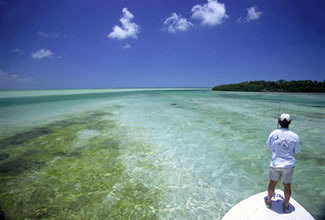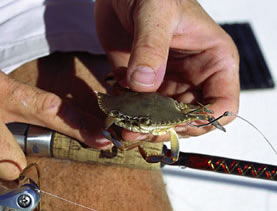May 20, 2013
By Jody Moore
Take a flats dream trip for Florida permit.
By Jody Moore

Tidal flats in the Big Pine Key area--particularly those bordering the Gulf of Mexico--tend to be the hard,"crunch" type bottom that permit prefer. |
It is a dream of mine to take a weekend-to-weekend, nine-day trip from one end of the Florida Keys to another, targeting permit exclusively. I would begin on the flats of Biscayne Bay, nearly in the shadow of downtown Miami. The second leg would be in the Lower Keys, and the adventure would end in the Mecca of all permit fishing, Key West.
I've fished all three areas, but never in one shot. In my opinion, these waters represent the world's top spots for flats permit in terms of big-fish availability and overall accessibility. For the average boat-owning flats angler, it would be a surprisingly affordable and exceptionally rewarding trip. The hardest part, for me anyway, would be scraping time away from family and career considerations.
The hottest months for this week-long safari would have to be May, June, July, August, September and even October. Permit don't mind the heat. In fact, they seem to thrive on it. These months also promise mild winds, which permit seem to prefer for getting up on the flats.
I would also select a week with late-morning incoming tides where the high tide will be particularly high. Permit aren't bonefish and need a fair amount of water to accommodate them on the flats. Use your Florida Sportsman Fishing Planner or other source to target the time of the tide and tides that are 1.8 feet or more in height.
A high tide is also good for permit as it offers stable water temperature. On a flat that cooks in the sun during an extreme low tide, for example, incoming water will be considerably hotter than the surrounding depths. The fish might be reluctant to explore the flat. This issue can be compounded if the incoming water is slow moving and doesn't flood past two feet in depth. Midday extreme lows on hot sunny days, coupled with a weak incoming tide, mean you aren't going to see much in the way of permit. This is especially true with the massive flats surrounding Key West and the bayside waters of the Lower Keys.
Having said that, permit do like warm water. Ideal temperature is somewhere north of 80, but below 90.
I would look forward to every late afternoon with great anticipation and fish the flats till sunset, which I feel is one of the best times for tailing permit. Permit seem to love tailing in oil-slick water, and they're really prone to do this during the last hours of the day. As a bonus, late in the day, you'll often have the flats to yourself.

The author, holds a good fish, favors hot summer days for sight-casting. |
I would pray for cookie-cutter days, too, with no dramatic changes in weather from day to day. Major changes in wind direction and velocity tend to drive permit off the flats. Wind in the 5- to 10-knot range puffing gently out of the southeast and then laying down in the afternoon is perfect for permit.
High-in-the-sky sun for clear visibility is a critical factor, too, especially on days with midday high tide. Unless fish are pushing noticeable head wakes or tailing, cloud cover crimps your ability to see them.
Each of the three stopping-off points I mentioned offer something a little different. Biscayne Bay, for instance, has two distinct and widely separated areas to fish. Easternmost oceanside flats from about Soldier Key south to Sands Key range from lush, dark seagrass to colorful sea fan gardens, to sandy, light-colored grassflats. The western and southern quarters, with small bays and bights, would seem at first glance not to be prime permit habitat. The bottom is dark grass, fringed by mangroves, and the water is slow-moving. But the permit are there; good numbers of big fish, too.
Another difference in the Bay as opposed to the Keys is you won't often see tailing permit here. Sure, you'll see fish tip a tail up occasionally, or find some laid-up fish finned out on the surface on calm days. It's just that you'll see more cruising flats edges, well below the surface, when the sun is high enough to spot them. Head-waking fish are common enough on calm days in the lower interior part of the Bay, so you can fish these fish fairly successfully during low-light conditions.
The Lower Keys and the waters west of Key West offer more tailing action. Here you'll witness some memorable scenes, such as permit standing on their nose and falling over backwards in an attempt to eat something off the bottom—presumably a crab. Or, permit tailing behind a mudding stingray or better yet, multiple permit tailing in loosely packed schools working slowly and methodically across a flat.

Black dorsal and pectoral fins are often what you see first. |
Something else you might see in the Lower Keys are schools of “bobbing” permit. These are fish positioned vertically in the water column, bobbing and occasionally poking their heads up past eye level out of the water. Expect to see this activity in the middle of wide, deep channels or at the mouth of a channel on an outgoing tide. Apparently, they are feeding on something on the surface.
The Lower Keys offer a whole host of areas to fish for permit and it would seem that any water deep enough to accommodate permit will have fish. Take out your chart and look at the string of islands and the surrounding flats on the northern edge from Upper Harbor Key down to Jewfish Channel. You are looking at prime permit country. As you can see, it is a big area and encompasses a tremendous amount of water rife with flats, channels and rocky outcroppings. Of course, a chart doesn't do the area justice and you have to experience it from the casting deck of a flats boat to even begin to comprehend the beauty of the region.
Key West has entirely different permit habitat, with some of the largest flats found anywhere in the Keys. West of Key West is an immense flat known as the Lakes. It's home to permit big and small and is bordered on the south side by an island chain surrounded by white sand flats and hard, grassy bottom. Along this island chain, which includes Man Key, Woman Key and Boca Grand Key, expect to see some of the biggest permit the Keys has to offer. I caught a personal best this past June of 33 pounds in this area, and have sighted fish that easily topped 45 pounds.
Just west of Boca Grand Key is the famed Marquesas Island atoll. There are permit of all sizes on both interior and exterior flats. Fishing is particularly good on the edges of channels leading into the atoll.
It is because of the countless permit in Key West, the huge expanse of flats that it offers and the relatively low angling pressure that I would spend four of my nine safari days here, ending my dream trip in what I consider the best spot of all.

Live crab is the bait of choice. |
----------------------
Bait and Technique
Crabs are at the top of the menu for permit. Think of tossing a Frisbee-sized target directly in front of a permit's face; that is where you want the crab to land. Another approach is to cast in front of and beyond a fish; with rodtip high, reel the crab so that it skims along the surface, then let it drop when it intersects the path of the fish.
Once the crab has landed where you want it, lower the rodtip and reel up the slack. If you are fortunate enough to see the fish eat, continue to keep your rodtip low and reel as fast as you can to set the hook. Raise the rodtip only after the fish is hooked. The main reason you want to reel down on the fish when it eats is to avoid pulling the hook out of its mouth.
I feel I get better hookups with offset hooks. If the hook isn't offset out of the box I'll take a pair of pliers and bend it ever so slightly. I'll also crimp on round splitshot just above the hook for better casting distance and control. Hook the bait up through one of the lateral points of the shell. Shrimp sometimes work, but seldom as well as crabs.
Braided, non-stretch microfilament fishing line is great for permit fishing. Not only do you get somewhat longer casts, you'll feel the slightest bump when the fish takes a bait. Without stretch, you can set a hook more effectively. Fluorocarbon leader is probably the top choice for most serious permit anglers, and should test 12 to 20 pounds. The mono leader can be anywhere from 4 to 12 feet long, whatever you are comfortable with.
Advertisement
If you are casting at a tailing fish in shallow water and are unable to tell if the fish has eaten your crab, watch the reaction of the tail. When the tail pokes up above the water, it's a good bet the fish is eating your bait. When you see the tail quiver excitedly, count on it.
A friend of mine recently ignored this “tell-tail” sign and ended up reeling in a small corner of crab carapace. The fish tailed on the crab, wagged its tail, pulverized the bait with its crushers and spit the hook before my buddy ever knew what happened. FS
First Published Florida Sportsman June 2005
Advertisement
Click Here to Have Florida Sportsman Magazine Delivered to Your Home

